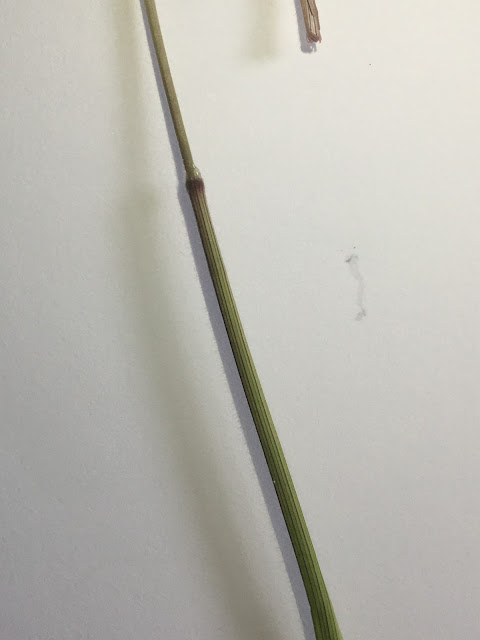 |
| Middle Heath Enclosure - Owlbeech Woods |
Yesterday saw the fourth of our now annual volunteer training days in Wildflower ID run by Dominic Price of the
The Species Recovery Trust. This is an excellent opportunity for some of our volunteers to gain valuable ID skills with the long term aim of getting some more help with our Higher Level Stewardship (HLS) survey work.
A group of 17 all met at Owlbeech Woods bright-eyed and bushy-tailed ready for an exciting morning exploring the heathland restoration project and learning how the heath is developing as it becomes more effectively managed. Some of the first species we looked at were Pill Sedge and Green-ribbed Sedge both of which were growing on the recently scraped areas and were good indicators of this dry area of heathland. We then moved into one of the vehicle tracks which has a nice open sword with lots of bare sandy soil. This gave us the chance to look at some lovely heathland species such as Heath Milkwort, Tormentil and Heath Bedstraw. We also looked at lots of different grasses and learnt some field tips for doing some of them vegetatively such as Yorkshire Fog below which has a 'stripy pajama' look about it on the stems. Hopefully one which all of the group will remember!
 |
| Yorkshire Fog - Holcus lanatus |
It was excellent to see so much Brown Bent on the scraped areas which I was really pleased about on a management level. We then moved to the boggy pools which are mainly in the Middle Heath Enclosure which produced a different sweet of species such as Bulbous Rush, Compact Rush and Yellow Sedge all of which were seemingly easy enough to identify by field characters such as the reddish base to the Bulbous Rush and the tennis ball-like tightness to the Compact Rush flowers.
 |
| Wet Meadow - Warnham LNR |
After a well earned lunch at Warnham LNR we headed out onto the Wet Meadow compartment of the Reserve and found a totally different mix of wetland clay-soil specialists which was a nice change from the heathland in the morning session. Here we noted lots of remnants from its intensive agriculture days such as Perennial Rye-grass and the like. Cock's-foot was much more abundant here and much of it which had not been grazed was flowering as in the picture below.
 |
| Cock's-foot - Dactylis glomerata |
There was a great deal more by way of flowering plants at Warnham than compared to the heathland which was no surprise due to the nature of the soil. Species in flower included Devil's-bit Scabious, Yarrow, Soft Rush, Hard Rush, Lesser Spearwort, Red Bartsia to name but a few. We also had the chance to learn how to ID Common Fleabane both by leaf and the more obvious yellow flowers as below.
 |
| Common Fleabane - Pulicaria dysenterica |
Many thanks to all of the volunteers that attended and I really hope you got something out of the day and also have remember some of the ID tips that Dominic imparted on us. A huge thanks also goes to the wonderful tuition of Dominic it is always a memorable day out and we very much look to welcoming him back in May 2018. A summary of most of the days species can be found below - I am sure I am missing plenty!
Species List - Owlbeech Woods
- Common Bent
- Sweet Vernal Grass
- Yorkshire Fog
- Pill Sedge
- Green-ribbed Sedge
- Dwarf Gorse
- Bulbous Rush
- Yellow Sedge
- Compact Rush
- Purple Moor Grass
- Tormentil
- Heath Milkwort
- Heath Bedstraw
- Brown Bent
- Common Ragwort
- Common Cudweed
- Common Heather
Species List - Warnham LNR
- Hard Rush
- Meadow Buttercup
- Creeping Buttercup
- Redshank
- Floating Sweet Grass
- Jointed Rush
- Broad-leaved Dock
- Water Pepper
- Common Bulrush
- Timothy Grass
- Fen Bedstraw
- Water Horse-tail
- False Fox-sedge
- Reed Canary-grass
- Greater Plantain
- Thyme-leaved Speedwell
- Common Nettle
- Creeping Bent
- Water Star-wort
- Water Plantain
- Silverweed
- Common Fleabane
- Lesser Spearwort
- Creeping Thistle
- Knotgrass
- Teasel
- Tall Fescue
- Red Bartsia
- Meadow Vetchling
- Field Bindweed
- White Clover
- Perennial Rye Grass
- Spear Thistle
- Water Forget-me-not
- Common Ragwort





At this time it appears like Expression Engine is the best blogging platform out there right now. (from what I've read) Is that what you are using on your blog? environmental journalism training in south africa
ReplyDelete